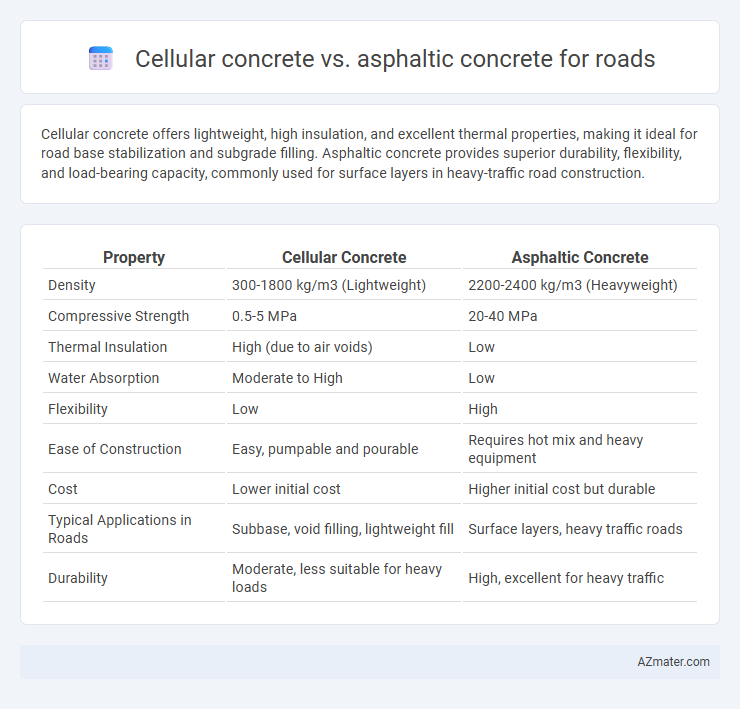Cellular concrete offers lightweight, high insulation, and excellent thermal properties, making it ideal for road base stabilization and subgrade filling. Asphaltic concrete provides superior durability, flexibility, and load-bearing capacity, commonly used for surface layers in heavy-traffic road construction.
Table of Comparison
| Property | Cellular Concrete | Asphaltic Concrete |
|---|---|---|
| Density | 300-1800 kg/m3 (Lightweight) | 2200-2400 kg/m3 (Heavyweight) |
| Compressive Strength | 0.5-5 MPa | 20-40 MPa |
| Thermal Insulation | High (due to air voids) | Low |
| Water Absorption | Moderate to High | Low |
| Flexibility | Low | High |
| Ease of Construction | Easy, pumpable and pourable | Requires hot mix and heavy equipment |
| Cost | Lower initial cost | Higher initial cost but durable |
| Typical Applications in Roads | Subbase, void filling, lightweight fill | Surface layers, heavy traffic roads |
| Durability | Moderate, less suitable for heavy loads | High, excellent for heavy traffic |
Overview of Cellular Concrete and Asphaltic Concrete
Cellular concrete, also known as foam concrete, is a lightweight, aerated material made by mixing cement, water, and foam to create a cellular structure with low density and high thermal insulation properties. Asphaltic concrete, commonly referred to as asphalt or bituminous concrete, comprises aggregates bound by bitumen, offering high durability, flexibility, and excellent load-bearing capacity for road surfaces. Cellular concrete is favored for its ease of placement and insulation benefits, while asphaltic concrete is preferred for its robustness and superior performance in heavy traffic conditions.
Material Composition and Properties
Cellular concrete consists of cement, water, and a foaming agent that introduces air bubbles, resulting in a lightweight and insulating material with low density and high thermal resistance. Asphaltic concrete is composed of mineral aggregates bound by bitumen, offering high strength, flexibility, and durability suitable for heavy traffic loads. The porous structure of cellular concrete provides excellent sound absorption and frost resistance, whereas asphaltic concrete excels in load-bearing capacity and resistance to rutting and cracking under temperature variations.
Strength and Durability Comparison
Cellular concrete exhibits lower compressive strength, typically ranging from 1.0 to 8.0 MPa, compared to asphaltic concrete which often exceeds 20 MPa, making asphaltic concrete more suitable for heavy traffic loads. Asphaltic concrete provides superior durability due to its resistance to weathering, thermal cracking, and rutting, whereas cellular concrete is more prone to moisture absorption and freeze-thaw cycles that can reduce its structural integrity. The open-cell structure of cellular concrete offers lightweight benefits but compromises long-term strength and durability, limiting its applications primarily to non-structural road base or insulation layers.
Weight and Density Differences
Cellular concrete exhibits significantly lower density, typically ranging from 300 to 1200 kg/m3, compared to asphaltic concrete, which averages around 2300 kg/m3, making cellular concrete much lighter. This reduced weight results in decreased load on the underlying road structure and improved ease of handling and installation. Asphaltic concrete's higher density provides superior strength and durability for high-traffic roads, while cellular concrete is preferred for lightweight fill and insulation purposes.
Installation Process and Construction Time
Cellular concrete offers a lightweight, flowable material that can be easily poured or pumped into place, reducing installation complexity and speeding up construction time compared to asphaltic concrete, which requires precise temperature control and compaction during laying. The rapid curing of cellular concrete allows for faster opening to traffic, while asphaltic concrete requires cooling periods and sequential layering for optimal performance. Overall, cellular concrete's installation process is less labor-intensive and more adaptable to varying site conditions, shortening project timelines effectively.
Cost Analysis and Economic Impact
Cellular concrete offers significant cost savings in road construction due to its lightweight nature, reducing the need for extensive earthwork and foundation reinforcement compared to asphaltic concrete. The lower material and transportation costs combined with improved thermal insulation properties contribute to a reduced life-cycle expenditure for cellular concrete roads. Asphaltic concrete, while providing higher durability under heavy traffic loads, entails higher initial and maintenance costs due to frequent resurfacing and repair requirements.
Environmental Impact and Sustainability
Cellular concrete offers superior environmental benefits compared to asphaltic concrete due to its lower carbon footprint, recyclability, and use of eco-friendly materials such as fly ash and recycled aggregates. Asphaltic concrete predominantly relies on petroleum-based binders, contributing to higher greenhouse gas emissions and non-renewable resource depletion. The porous nature of cellular concrete enhances stormwater management and reduces urban heat island effects, promoting sustainable urban infrastructure development.
Performance in Various Climates
Cellular concrete offers superior thermal insulation and excellent freeze-thaw resistance, making it ideal for cold climates where asphaltic concrete may suffer from cracking and rutting. Asphaltic concrete performs well in warm and moderate climates due to its flexibility and ability to withstand heavy traffic loads without deformation. Both materials' durability depends on proper mix design and maintenance tailored to specific environmental conditions.
Maintenance Requirements and Lifespan
Cellular concrete exhibits lower maintenance requirements due to its lightweight and high drainage properties, reducing water damage and cracking compared to asphaltic concrete. Asphaltic concrete, while more durable under heavy traffic loads, requires periodic sealing and patching to address surface wear and deterioration from temperature fluctuations. Lifespan of cellular concrete typically ranges from 20 to 30 years with proper maintenance, whereas asphaltic concrete can last 15 to 25 years but demands more frequent upkeep to preserve structural integrity.
Suitability for Different Road Applications
Cellular concrete offers excellent suitability for lightweight fill and sub-base layers in road construction due to its low density, high flowability, and good insulating properties, making it ideal for areas requiring reduced load on weak soils. Asphaltic concrete excels in surface layers because of its high durability, flexibility, and resistance to traffic loading and weathering, ensuring long-lasting pavements on highways and urban roads. The choice between cellular and asphaltic concrete depends on specific road application needs, such as structural support, load-bearing capacity, and environmental conditions.

Infographic: Cellular concrete vs Asphaltic concrete for Road
 azmater.com
azmater.com